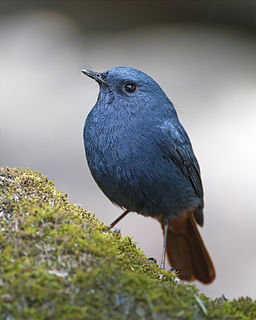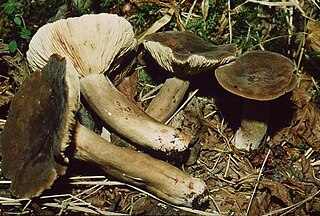Related Research Articles

The western grey kangaroo, also referred to as a western grey giant kangaroo, black-faced kangaroo, mallee kangaroo, and sooty kangaroo, is a large and very common kangaroo found across almost the entire southern part of Australia, from just south of Shark Bay through coastal Western Australia and South Australia, into western Victoria, and in the entire Murray–Darling basin in New South Wales and Queensland.

The sooty oystercatcher is a species of oystercatcher. It is a wading bird endemic to Australia and commonly found on its coastline. It prefers rocky coastlines, but will occasionally live in estuaries. All of its feathers are black. It has a red eye, eye ring and bill, and pink legs.

The dusky caenolestid, also known as Tate's shrew opossum, is a shrew opossum from South America. The dusky caenolestid is characterized by a dark brown coat with a lighter underbelly, soft and thick fur, and a loosely haired tail. A nocturnal animal, the dusky caenolestid lives on trees and feeds on insects and small invertebrates and vertebrates. It occurs in alpine and páramo forests in northern and western Colombia, Ecuador, and western Venezuela. The IUCN classifies this shrew opossum as least concern.

The lava gull, also known as the dusky gull, is a medium-sized gull and a member of the "hooded gull" group. It is most closely related to the Laughing gull and Franklin's gull and is the rarest gull in the world. It is endemic to the Galapagos Islands.

The plumbeous water redstart is a passerine bird in the Old World flycatcher family Muscicapidae. It is found in South Asia, Southeast Asia and China. Males are slate blue in colour, while females are grey. The bird's common name refers to its colour which resembles lead. They tend to live near fast-moving streams and rivers.
Galadra is a monotypic moth genus of the family Crambidae described by Francis Walker in 1865. It contains only one species, Galadra rhomboidata, described by the same author in the same year, which is found in New Guinea.
Patissodes is a monotypic moth genus of the family Crambidae described by George Hampson in 1919. Its only species, Patissodes fulvinotata, described by the same author in the same year, is found in Singapore.
Norsia is a monotypic moth genus in the family Geometridae described by Francis Walker in 1867. Its only species, Norsia vincta, described by the same author in the same year, is found in Colombia.

Lactarius fuliginosus, commonly known as the sooty milkcap, is a species of fungus in the family Russulaceae. The medium-sized fruit bodies have velvety, grayish-brown caps and crowded gills. It is found in deciduous forests of Asia, Europe, and North America.
Auchmera is a monotypic snout moth genus described by George Hampson in 1930. Its single species, Auchmera falsalis, was described by the same author in 1908. It is found in India.
Borosia is a monotypic snout moth genus described by László Anthony Gozmány in 1959. Its only species, Borosia aegyptiaca, described by the same author in the same year, is found in Egypt.
Caustella is a monotypic snout moth genus in the family Pyralidae described by George Hampson in 1930. Its only species, Caustella micralis, was described by the same author in 1896. It is found in Sri Lanka.
Geropaschia is a monotypic snout moth genus. Its only species, Geropaschia grisealis, is found in Brazil. The genus was described by George Hampson in 1917Beccaloni, G.; Scoble, M.; Kitching, I.; Simonsen, T.; Robinson, G.; Pitkin, B.; Hine, A.; Lyal, C., eds. (2003). "Geropaschia". The Global Lepidoptera Names Index. Natural History Museum. Retrieved October 26, 2018. and the species had been described by the same author one year earlier.
Heterocrasa is a monotypic snout moth genus described by William Warren in 1896. Its only species, Heterocrasa expansalis, described by the same author in the same year, is found in India.
Lacipea is a monotypic snout moth genus described by Francis Walker in 1863. Its only species, Lacipea muscosella, was described by the same author in the same year and is found in Sri Lanka.
Lambaesia is a genus of snout moths described by Hans Rebel in 1903. Its single species, Lambaesia caradjae, was described by the same author in the same year. It is found in Algeria.
Mesciniodes is a monotypic snout moth genus described by George Hampson in 1901. Its only species, Mesciniodes subinfractalis, was described by the same author in the same year. It is found on Celebes and Borneo.
Mimicia is a monotypic snout moth genus described by Aristide Caradja in 1925. Its only species, Mimicia pseudolibatrix, described by the same author in the same year, is found in China.
Ocydina is a monotypic snout moth genus described by Edward Meyrick in 1936. Its single species, Ocydina syngrammaula, described by the same author in the same year, is found in Congo.
Agrisius fuliginosus is a moth of the subfamily Arctiinae. It is found in Japan, China and India.
References
- ↑ Nuss, M.; et al. (2003–2011). "GlobIZ search". Global Information System on Pyraloidea. Retrieved September 29, 2011.
- ↑ Beccaloni, G.; Scoble, M.; Kitching, I.; Simonsen, T.; Robinson, G.; Pitkin, B.; Hine, A.; Lyal, C., eds. (2003). "Honorinus fuliginosus". The Global Lepidoptera Names Index . Natural History Museum . Retrieved May 6, 2018.
| This Phycitinae-related article is a stub. You can help Wikipedia by expanding it. |